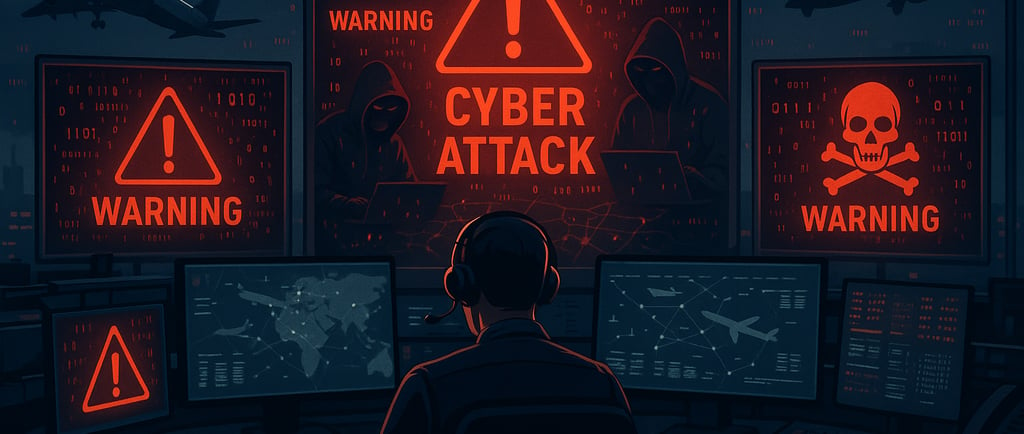
Aviation Under Attack
The Scattered Spider Cybersecurity Crisis
6/30/20256 min read


Aviation Under Attack: The Scattered Spider Cybersecurity Crisis
The aviation industry is facing an unprecedented cybersecurity crisis. A sophisticated hacking group known as Scattered Spider has launched a coordinated assault on airlines and transportation companies worldwide, fundamentally changing how we think about aviation security. This isn't just another data breach—it's a wake-up call for an entire industry that has historically prioritized physical safety over digital security.
Meet Scattered Spider: The New Face of Cybercrime
Scattered Spider, also operating under the aliases UNC3944, Octo Tempest, and Muddled Libra, represents a new breed of cybercriminal organization. What makes them particularly dangerous isn't just their technical sophistication—it's their mastery of human psychology.
The FBI has issued warnings that Scattered Spider is actively targeting airlines with ransomware and data extortion attacks. Their message is clear: "Anyone in the airline ecosystem, including trusted vendors and contractors, could be at risk." This expansion into aviation marks the third major U.S. business sector the group has targeted in just two months, following successful campaigns against insurance and retail companies.
The group consists primarily of young, English-speaking hackers from the United States and United Kingdom. Unlike traditional cybercriminals who rely heavily on technical exploits, Scattered Spider has perfected the art of social engineering—essentially tricking people into giving them access to systems that should be secure.
Recent Attacks Hit Close to Home
The impact became undeniably real in June 2025 when several major airlines fell victim to cyberattacks:
Hawaiian Airlines disclosed a cybersecurity incident on June 26 that affected their IT systems. While flights continued operating safely, the attack prompted the airline to engage federal authorities and cybersecurity experts for investigation and remediation.
WestJet Airlines, Canada's second-largest carrier, reported a cyberattack on June 13 that remained unresolved for over a week. The incident affected internal systems and the WestJet app, causing intermittent interruptions for customers. Industry sources have linked this attack directly to Scattered Spider.
Charles Carmakal, CTO of Google's Mandiant Consulting, confirmed that his team is "aware of multiple incidents in the airline and transportation sector which resemble the operations of Scattered Spider." The timing and methodology of these attacks strongly suggest coordinated action by the group.
How They're Getting In: The Art of Deception
What makes Scattered Spider so effective isn't necessarily their technical prowess—it's their ability to manipulate people. Their attacks typically unfold like this:
The Setup: They research their targets extensively, using publicly available information about employees, organizational structures, and business processes. They particularly target system administrators, CFOs, COOs, and CISOs.
The Approach: Scattered Spider operators impersonate employees or contractors and contact IT help desks. They're incredibly convincing, often knowing enough internal details to pass initial verification checks.
The Breakthrough: They convince help desk personnel to grant them access to high-value accounts or add unauthorized multi-factor authentication devices to compromised accounts. They've developed sophisticated methods to bypass MFA protections, including techniques like "push bombing" and SIM swap attacks.
The Expansion: Once inside, they don't just steal data—they position themselves for maximum impact. They target managed service providers and IT contractors to achieve "one-to-many" access, allowing them to breach multiple client networks through a single compromise.
The Payoff: After stealing sensitive data for extortion purposes, they often deploy ransomware to maximize their financial returns. They've established partnerships with major ransomware operators including ALPHV/BlackCat, RansomHub, and DragonForce.
Why Airlines Are Prime Targets
The aviation industry presents an almost irresistible combination of valuable assets and vulnerabilities:
Rich Data Goldmines: Airlines hold vast amounts of personally identifiable information, including passport details, financial data, and travel patterns. A single breach can affect millions of passengers—imagine the Cathay Pacific breach that compromised 9.4 million records, but worse.
Critical Infrastructure Status: Aviation systems are classified as critical infrastructure, making disruptions particularly impactful. When airlines go down, the effects ripple across multiple economic sectors.
Complex Digital Ecosystems: Modern aviation relies on interconnected systems spanning reservations, baggage handling, security screening, and flight operations. This complexity creates multiple attack vectors and makes comprehensive security challenging.
Pressure to Pay: Airlines operate on thin margins with 24/7 operational requirements. They're more likely to pay ransoms quickly to restore service, making them attractive targets for financially motivated criminals.
The Numbers Don't Lie
The statistics paint a sobering picture of escalating threats:
Cyberattacks in the aviation sector increased by 24% worldwide in the first half of 2025
The transportation sector experienced a 181% year-over-year increase in data breaches in 2023, affecting over 12 million individuals
Ransomware attacks on supply chain players surged by 600% since 2024
Advanced persistent threat detections targeting U.S. transportation increased by 136% in Q1 2025 compared to Q4 2024
Perhaps most concerning: 65% of aviation cyberattacks target airports, while 35% focus on airlines directly. This means the threat extends far beyond individual carriers to the entire aviation ecosystem.
The Systemic Problem: Aging Infrastructure Meets Modern Threats
The aviation industry faces a fundamental challenge: much of its critical infrastructure was designed decades ago, long before cybersecurity became a primary concern. The Foundation for Defense of Democracies put it bluntly: "We are pushing decades-old aviation systems to handle high-demand travel 24/7, and the cracks are showing."
The Federal Aviation Administration has acknowledged the need for comprehensive modernization of the nation's air traffic control system with enhanced cyber resilience. However, the pace of technological advancement in aviation hasn't kept up with the evolving threat landscape.
While the Transportation Security Administration has implemented new cybersecurity directives requiring network segmentation, access controls, and threat monitoring, enforcement and compliance remain challenging across the diverse aviation ecosystem.
Real-World Consequences
The impact of these attacks extends far beyond temporary inconvenience:
Operational Disruptions: While most recent attacks haven't directly affected flight operations, system disruptions can cause significant delays and passenger inconvenience. Attacks on reservation systems, baggage handling, and check-in processes can cripple airport operations even when aircraft continue flying.
Financial Damage: Hawaiian Airlines' parent company experienced a 25% year-to-date decline following their cybersecurity incident. Direct costs from incident response, system restoration, and regulatory fines can reach millions of dollars.
Legal and Regulatory Consequences: Airlines handle enormous amounts of sensitive passenger data, making them subject to strict privacy regulations including GDPR and CCPA. Breaches can trigger substantial fines, class-action lawsuits, and enhanced regulatory scrutiny.
Fighting Back: Industry Response and Defense Strategies
The aviation industry isn't sitting idle. Companies are implementing comprehensive defensive measures:
Technical Safeguards include network segmentation to prevent lateral movement of attackers, enhanced multi-layered authentication systems, and real-time threat detection capabilities that can identify suspicious activities as they happen.
Human-Centered Security has become crucial given Scattered Spider's reliance on social engineering. This includes comprehensive employee training programs focused on recognizing sophisticated manipulation attempts and enhanced help desk security protocols for password resets and system access requests.
Industry Collaboration is expanding, with enhanced information sharing about cyber threats and best practices. The FBI is actively working with aviation partners to address Scattered Spider activities, while regulatory bodies are implementing more stringent cybersecurity requirements.
Looking Ahead: A Transformed Industry
The Scattered Spider campaign represents a watershed moment for aviation cybersecurity. The global aviation cybersecurity market is expected to grow from $4.6 billion in 2023 to $8.42 billion by 2033, reflecting the industry's recognition of this critical need.
This investment will likely focus on legacy system modernization, advanced AI and machine learning-based threat detection, and comprehensive risk management approaches that address both technical and human vulnerabilities.
Regulatory bodies are implementing more stringent requirements, including mandatory incident reporting, stricter oversight of vendors and contractors, and requirements for real-time cybersecurity monitoring and response capabilities.
The Bottom Line
The battle against Scattered Spider and similar threat actors represents more than a technical challenge—it's a fundamental test of the aviation industry's ability to secure its critical infrastructure in an increasingly digital world.
The current wave of attacks serves as a critical wake-up call for an industry that has historically prioritized safety and operational efficiency over cybersecurity. As airlines and airports work to defend against increasingly sophisticated threats, the sector's approach to cybersecurity must evolve from reactive to proactive, from siloed to integrated, and from compliance-focused to risk-based.
The outcome of this struggle will determine whether aviation remains a trusted, secure mode of transportation or becomes another casualty in the ongoing cyber warfare that threatens our critical systems. The choice is clear: adapt and secure, or risk becoming the next headline in an increasingly dangerous digital landscape.
Sources for Further Reading
CNN Business - "FBI warns airlines about cyberattacks from criminal group" - Comprehensive coverage of the FBI's warning and recent aviation sector attacks.
TechCrunch - "FBI and cybersecurity firms say Scattered Spider hackers now targeting airlines" - Detailed analysis of Scattered Spider's methods and recent targeting of the transportation sector.
The Hacker News - "FBI Warns of Scattered Spider's Expanding Attacks on Aviation and Transportation" - Technical breakdown of the group's social engineering tactics and security implications.
Financial Services Information Sharing and Analysis Center (FS-ISAC) - "Scattered Spider & BlackCat Ransomware Mitigation Guidance" - Official industry guidance on defending against these specific threats.
Cybersecurity Dive - "Aviation faces growing cyber risks as aging tech meets modern threats" - Industry analysis of systemic vulnerabilities and modernization challenges in aviation cybersecurity.
Innovate
Building websites and securing your digital presence.
Connect
Support
Info@sinistergatedesigns.com
© Sinister Gate Designs, LLC 2025. All rights reserved.
